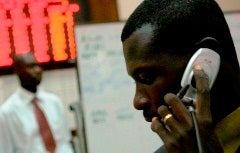 Let's think together: Every Sunday the World Bank in Tanzania in collaboration with The Citizen wants to stimulate your thinking by sharing data from recent official surveys in Tanzania and ask you a few questions.
Let's think together: Every Sunday the World Bank in Tanzania in collaboration with The Citizen wants to stimulate your thinking by sharing data from recent official surveys in Tanzania and ask you a few questions.
The mobile phone is a truly novel device. It comes in just as handy and as easily when we need to communicate about the serious things as to chat about the simpler things in life. Mobiles are not only being used as radios and flashlights but they are also delivering banking and financial services to those who urgently need them.
Increasingly, people around the world, especially in Africa, are paying their school fees, healthcare and utility bills using mobile phones today. Businesses use mobile money phones to pay their staff and suppliers. Poor people who have never entered a bank are using mobile services to send or receive remittances and to save their money.
‘Mobile money’, as it has been dubbed, is growing at an amazing pace on the continent and at an even faster rate in East Africa as shown by the following statistics for Tanzania:
- The total number of registered mobile customers surged from 14,000 in June 2008, to 19.4 million in November 2011, to 20.4 million in November 2012.
- Money stored in mobile accounts increased from Sh3 billion in June 2009 to Sh157.8 billion in November 2012.
- The number of monthly transactions increased from 1.9 million in 2010 to 48 million in September 2012.
- The value of transactions increased from Sh1.4 million in 2007 to Sh1.8 billion in 2010, to Sh1.7 trillion in 2012. For the month of September 2012 alone, the value of mobile money transactions in Tanzania was about 14 percent of total deposits held by commercial banks.
Mobile money was used by one out of four households in Tanzania in 2011. This is much lower than in Kenya (73 percent) but significantly higher than middle-income countries like Brazil and Argentina (only 1 percent).
However, Its use varies according to some households' characteristics.
- Those in the richest quintile are 15 times more likely to have used mobile money than those in the poorest quintile
- A person who has completed secondary education school is 15 times more likely to have used mobile money than someone without primary education.
- Business owners and wage earners are five times more likely to have used mobile money than subsistence farmers.
- Mobile money users are five times more likely to have a bank account.
The fantastic growth of mobile money has been attracting many investors. ’Big’ communication companies and commercial banks are jumping on this bandwagon wave, sometimes making strategic alliances to get make the most out of it. At the other end of the spectrum, small innovators have also been coming up with new products, targeting new consumers or developing new ways to do business.
All these developments raise a number of questions:
- Do you agree that mobile phones provide a revolutionary form of banking in Tanzania? Are they a threat or a complement to traditional banking?
- To what extent does the rapid rise of mobile banking present risks, say with regard to increased money laundering, identity theft, ,consumer vulnerability and/or other ways?
- Will mobile money help reduce the gap between the rich and the poor?
- Should mobile money transfers cross borders? Will it help deepen regional integration?
- Should mobile money be more tightly regulated? Would over-regulation slow or halt the mobile revolution and hurt economic growth?
Note: The statistics above are based on the Bank of Tanzania’s monetary policy statements, the 2010/11 National Panel Survey, and a 2012 UNTCAD report. All are publicly available.




Join the Conversation